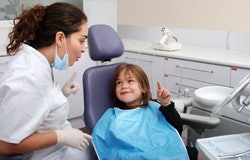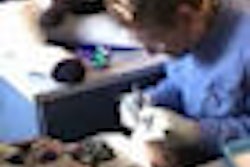
Before the needle touched him, the four-year-old started crying. So, David E. Thome, D.D.S., knew he had to act quickly. "We use sleepy juice here," he said. "It will put your tooth to sleep so it won't feel anything at all." He then applied a topical anesthetic and challenged the boy to find his belly button with his hands. Being careful not to let him see the syringe again, Dr. Thome quickly administered the shot.
That kind of kid-savvy know-how has helped the Cameron, Missouri-based Dr. Thome grow the number of children under age 15 to more than two-thirds of his patient base. It’s an exceptional number for a general dentist. Children this age make up 20 percent of the general population, according to U.S. Census figures. But a 2003 study in the Journal of the American Dental Association found that they comprise a much smaller proportion of most dentists’ practices. And only 2 percent of all dentists specialize in pediatrics, so the majority of general dentists are overlooking lots of potential clients."They aren’t maximizing their potential revenue," says Marvin Berman, D.D.S., co-author of Essentials of Modern Dental Practice and producer of several videotapes on child management for dentists.
There's no magic bullet when it comes to soothing fearful kids, Dr. Thome and Dr. Berman agree. But simple strategies, applied carefully, can make appointments successful for everyone. What follows are seven tips culled from interviews with some of the country’s leading experts on calming kids in the dental chair.
One: Prepare the child -- and the parent
Even if you have an advanced degree in child psychology -- or raised six kids -- it’s almost impossible to know how kids will react in any given stressful situation. And for a child, what could possibly be more anxiety-producing than a visit to the dentist, even for a routine cleaning? The quiet formality of the waiting room; the sleek, severe dental chair; the harsh overhead light; the whirring buzz of the drill -- it’s the stuff of kids’ nightmares.
 |
| There's no magic salve when it comes to soothing fearful kids, but simple strategies, applied carefully, can make appointments successful for everyone. |
Such terror, more than anything, leads to the kicking and screaming so many general dentists dread. A 2007 study published in the International Journal of Paediatric Dentistry, showed that kids’ dental fear is the most important reason general dentists refer patients to pediatric specialists.
Another study from the same journal suggests that the mother’s state of anxiety, and the child’s level of maturity, also contribute to potentially difficult behaviors.
That study is consistent with others going back to the 1970s, says Paul Casamissimo D.D.S., M.S., chair of pediatric dentistry at Ohio State University College of Dentistry and past president of the American Academy of Pediatric Dentistry. The research "consistently shows that if the parent -- usually Mom -- is anxious, then the child will be, too."
Smart dentists who cater to kids provide parents with as much information as possible and patiently answer every question before the first appointment.
When parents calls to make an appointment, says Dr. Casamissimo, chat with them reassuringly. Send them a welcoming letter with a list of frequently asked questions and answers, brochures showing families having fun at your office and pictures of your waiting room with kid-friendly amenities. Instruct them not to share their anxiety with their children.
"I ask parents to be prepared to be silent observers when they come in with their child," says Dr. Thome, "and encourage them not to comment during the appointment."
Before their first visit, Brian Quo, D.D.S., M.A., a Palo Alto, Calif., pediatric dentist, strongly recommends that parents read their kids a children’s book about visiting the dentist. He especially likes Show Me Your Smile!: A Visit to the Dentist by Christine Ricci and Robert Roper.
Dr. Quo invites parents to come by prior to the visit and borrow the book or suggests they go to a library for similar titles. Such books help kids become familiar with names of dental instruments, the office chair, the overhead light, and more.
Two: Design for them
When the child finally arrives, a comfortable, kid-friendly environment helps set the right tone. If your office has a funky old sofa and copies of Field and Stream magazine on the waiting room table, neither parent nor child will have a good first impression.
Dr. Quo’s waiting room is designed with kid-friendliness in mind. Bright colors, walls covered with murals, and a ceiling hung with airplanes provide the backdrop where kids can read books; watch TV; use a Playstation; build with Legos; or play with toys, maps and puzzles. "I want the waiting room to feel like a child’s own bedroom," he says. He provides materials for kids ages six months to 15 years of age.
At the same time, you don't want the space to be a turn-off to adult patients. Dr. Thome’s office features a children’s waiting room separate but visible from the main waiting room.
Three: Meet them and greet them
Of course, human interactions matter even more. Sometimes, being patient and taking the time to establish an informal relationship may be all that's necessary. Matt Comfort, D.D.S., a general dentist in Rocklin, California, was scheduled to see an extremely fearful little three-year-old. Dr. Comfort had him visit the office once a week for about two months. He'd just come in and play a game, and Dr. Comfort would have him sit in the dental chair but not work on him. After the eighth or ninth week, Dr. Comfort said "How about you help us clean your teeth?" He let the boy hold the instrument, and before long he had a happy patient.
Kid-savvy dentists also know how to make their smallest patients feel important. Kellie Paxton, D.M.D., a general dentist at the University of Iowa dental clinic, always pretends she's been happily waiting to see them for a long time. "I am so happy to see you!" she says with a smile. "I've been looking forward to your appointment all day. Look at those cute shoes and your bright-colored sweater. You got all dressed up today." Kids appreciate the validation, she says, and it takes their mind off dentistry. She also recommends making this connection in the waiting room rather than the operatory.
"It should feel like you have a bunch of moms in the office."
To avoid coming off as an intimidating presence, when Dr. Quo first meets a new patient, he makes it a point to get down to the child’s level -- often on one knee. "I give high-fives all around," he says.
Equally valuable is making sure the child respects your authority. "I let the child know he’s not in charge. I become more serious," says Dr. Quo. "I make sure to look the child in the eye when talking to him. It’s almost a form of tough love, but once the child knows you mean business, he’s usually OK with that."
Coach your staff in these approaches too, advises Dennis J. McTigue D.D.S. M.S., professor of pediatric dentistry at Ohio State University College of Dentistry. "It should feel like you have a bunch of moms in the office." When hiring, ask potential employees if they're willing to chat with kids and even get on the floor to play with them.
Four: Position their parents
Conventional wisdom has long dictated that parents should spend the appointment in the waiting room. Citing the research on how parents' attitudes and anxieties affect their childrens' behavior in the chair, many dentists still adhere to this practice. "The dentist needs to gently separate the parent from the child," says Dr. Quo. Parents may feel that they know their child best and want to help their child through the experience, but they don’t always know when to step back. Their presence may encourage the child to cling or resist treatment.
But some dentists welcome parents in the operatory. Dr. McTigue's treatment team involves the parent, dentist, and child. He prefers that the parent accompany the child all the way to the chair. That way, the importance of dental care is clearly reinforced with the child.
But Dr. McTigue cautions parents about what to say and what not to say in such circumstances. "I don’t want a parent sitting next to child asking me ‘Is this going to hurt her?’" he says. He makes it clear to the parent that if the child cries, it’s perfectly normal. And he acknowledges that bringing parents into the operatory means that the dentist may need to calm the parents as well as the children.
Five: Show them what you’ve got
During the first visit, introduce the child to the familiar before the unfamiliar, according to Dr. Berman. Instead of giving the child a "ride" in the chair (which frightens some kids) or showing her your tools, give her something familiar and talk about familiar things. Hand her a toothbrush and ask her to show you how she brushes her teeth. Offer her a glass of water.
If you allow the parents to be with their children, ask Mom or an older sibling to take the chair first. This technique is called "modeling," with the child watching a family member happily undergo dental care.
Dr. Berman's method echoes the "Tell, show, do" approach described in the American Academy of Pediatric Dentistry’s Guideline on Behavior Guidance for the Pediatric Dental Patient. "The technique involves verbal explanations of procedures in phrases appropriate to the developmental level of the patient (tell); demonstrations for the patient of the visual, auditory, olfactory, and tactile aspects of the procedure in a carefully defined, nonthreatening setting (show); and then, without deviating from the explanation and demonstration, completion of the procedure (do)."
"Simply put, ‘Tell, show, do’ desensitizes the child so she doesn't feel freaked out," says Dr. Mike Ignelzi, a pediatric dentist and orthodonist in Greensboro, N.C. For example, when talking about the rotating brush used for cleaning, he’ll tell the patient: "This is my friend Mr. Bumpy. He's nice and soft." He flexes it on his thumbnail, then on her thumbnail. "He also spins around and makes noise." He shows her how by cleaning her thumbnail. This way she experiences it, hears it, and becomes familiar with it before the brush goes in her mouth. Then you do it, perhaps saying, "Now we're going to clean just one tooth."
When practicing "tell, show, do," says Dr. Ignelzi, include the five senses. What is the child going to see? (Show her which tool you'll be using.) Hear? (Let her hear the brush spin before you put it in her mouth.) What is she going to taste and smell? (Let her choose the flavor and taste it ahead of time.) Feel? (Let her touch the rubber tip and feel it spin on her thumbnail.)
Six: Distract them
Young children can't concentrate for long periods, so they’re easily distracted -- a real advantage for the dentist. "Start up a conversation about his best friend, teacher, pet, new tennis shoes -- ‘Wow, those are neat. Did your mom buy them for you?’" says Dr. Ignelzi.
Dr. Ignelzi describes a teaching video that shows how useful distraction can be. In the video, the dentist is about to give a child a shot, and he tells her to open up wide. When she does, he says, "Wow, you open up really big! I can see your toes!" You can see wheels turning in the child’s head: Can he really see down to my toes? Am I really opening up that wide? What does he see? Meanwhile, the dentist gives her a shot and it's over before she's done thinking it through.
Other kid-friendly distractions, situated right by the dental chair, can include videos and headsets (depending on the child’s age), which take the child’s focus away from what you're doing.
Even with distraction, some kids will cry through the entire procedure, but many pediatric dentists -- after getting permission from parent to continue beforehand -- keep on working, even if the child is screaming.
"If you can't stand to see a child cry, then you're in the wrong business," says Dr. Berman. He doesn’t take the crying personally and doesn’t ask the child to stop. Rather, he continues trying to distract the child’s attention.
Seven: Sweeten their memories
Inevitably some children will leave an appointment determined never to set foot in an operatory again. However, even for those kids, hope has emerged from another 2007 study reported in the International Journal of Paediatric Dentistry. Lead author Jacqueline E. Pickrell, Ph.D., a cognitive psychologist in the Department of Dental Public Health Sciences at the University of Washington, explains that "memory restructuring," can improve children's attitudes and behavior on subsequent visits.
Her findings show dentists can sweeten a child’s memory of a dental visit several weeks later by reinforcing the positive aspects of their behavior. In the study, children who got praise from a researcher like "you really didn’t cry that much," or "you were very brave when the dentist examined you," felt less anxiety and behaved better in subsequent dental procedures than children in a control group who just chatted with the researcher.
It’s one more piece of evidence showing that small things matter.



















